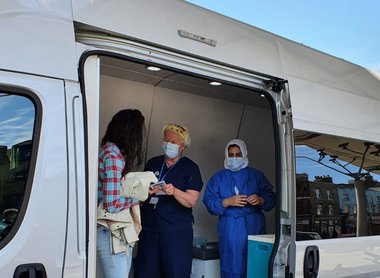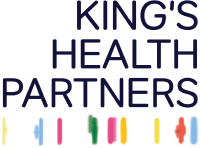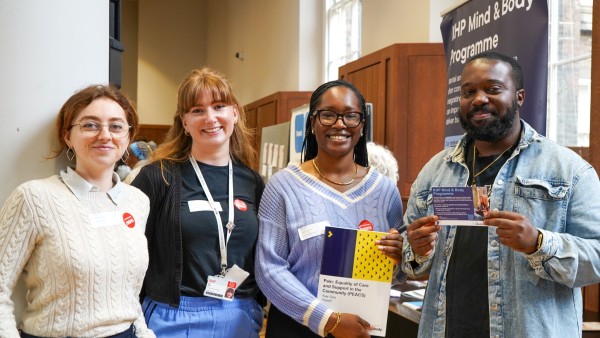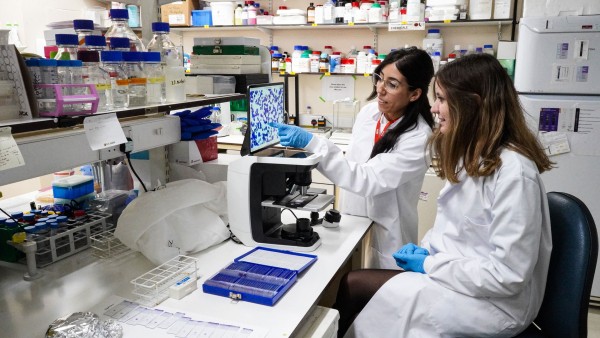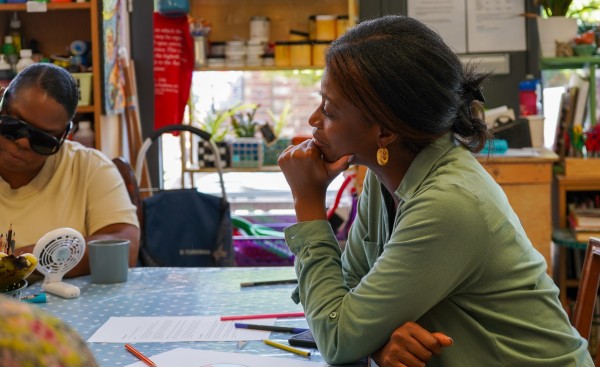2 June 2021
Teams of healthcare professionals working with volunteers from the community are delivering COVID-19 vaccine advice and jabs in vans, buses and ambulances, reaching south east London communities who may not otherwise have been reached through existing models of healthcare delivery.
Dr Rachna Chowla, Joint Director of Clinical Strategy, King’s Health Partners, interviews primary care network colleagues Brenda Donnelly and Harprit Lally, from the South Southwark Primary Care Network, about their novel approach engaging with residents in Southwark on questions about the COVID-19 vaccine. Brenda, Harprit and Rachna talk about having conversations with people outside Peckham Library, one sunny Sunday and delivering jabs, in the heart of the community, and how this innovative method of engagement around healthcare delivery could be used for other health issues.
Rachna: Brenda and Harprit, please describe your roles.
Brenda: I am an advanced Nurse Practitioner in General practice and have the privilege of being a Clinical Director for one of the neighbourhoods in the south Southwark Primary Care Network (PCN).
Harprit: I am the programme manager for the South Southwark PCN. My role involves supporting the development and delivery of a PCN workforce, including social prescribers and pharmacists, and facilitating collaborative working across practices and the broader system.
Rachna: How would you describe your involvement in vaccinating people in the community?
Brenda: I have been involved in the delivery of COVID-19 vaccines since December 2020, the very beginning, when it was all very new. Together with other members of my team, we initially set up a vaccination centre in the Tessa Jowell Health centre, involving new ways of working and a safe layout for patients and staff to access services. We repurposed an area of the building within a few days. We also took into account how we would need to modify the building’s layout as vaccine delivery progressed to reach different age groups.
Harprit: Alongside Brenda, our vaccination lead, I was involved in designing how we would deliver vaccines to Southwark residents, working on areas such as staffing and clinic configuration. More recently, with the ability to move AstraZeneca, we created a new approach to delivering vaccines and information, by going out to our local communities, using what we call vaccine vans.
Rachna: How are vaccine vans organised, and why was this approach used?
Harprit: These vans are run by a team of around five to eight healthcare professionals and volunteers and set themselves up in the middle of south Southwark communities, for example near shopping centres, or in supermarket carparks, or outside libraries, to create the space for people to have a conversation with a healthcare professional about the vaccine. We give advice and information on COVID-19 vaccines and can help people sign-up to a GP if they do not have one. For those individuals interested in taking up the vaccine, following a discussion with us about what it would entail and their consent, we administer COVID-19 vaccines safely inside the vans – up to 60 to 80 per day. We have been able engage with people in our community in a completely different way and more on their terms.
Brenda: What struck me about this approach is being able to reach populations who we had missed completely and who, as Harprit mentioned, may not be registered with GPs or engaged with healthcare services at all previously. This is a novel approach and we all really enjoyed working in this way.
Rachna: Yes, most certainly. In particular, I remember a gentleman who came to speak with us about the vaccine, who was drinking alcohol at the time and had a can of beer in his hand. Brenda, he wanted to speak to you because you are from the same lovely part of Ireland, and he felt comfortable talking with you. You assessed his capacity to consent and minimised his risk by giving him the vaccine. We could care for him in his community, whereas he might never have made it to his GP practice, or because he had a can of something in his hand, might have been asked to come back another time had he presented at a surgery.
Rachna: What the vaccine van model shows, just as you both have just said, is when you take healthcare delivery into the heart of a community, it changes the dynamic - you get to have a different conversation with people, and you can engage with people in a different way. There is also the added benefit of people engaging in their health, when we do out-reach work like this on COVID-19 vaccines, also gives us the opportunity to speak with them about other aspects of their health.
Brenda: Absolutely. There have been also so many different cultures and languages coming to engage with us.

[Pictured from left to right: Dr Rachna Chowla, Bola Olatunde, Brenda Donnelly, Barry Hall, Dr Kishor Vasant, Barbara Williams, Harprit Lally.]
Rachna: Yes, I remember that day. There is something about our colleagues working in the vaccine vans, representing the languages and ethnicities of the local populations with whom we were talking. The day I was working with you, we had at least seven different languages spoken within our vaccine van team!
Rachna: What were the benefits of providing access to healthcare in this way?
Brenda: Just as Rachna has mentioned, people should not have to come to us for healthcare, but we can take healthcare to them. One of the things that drives me in my role is addressing social and health inequalities. Once the vaccination centre was established, I was conscious that the individuals coming into the centre to take up the COVID-19 jab were not representative of all of our south Southwark London communities. Data showed us that we were having a lower uptake of the COVID-19 vaccine from black African and Latin American populations, for example. Transporting COVID-19 jabs directly into the community is one way of addressing health inequalities and reaching other demographics who were not at that time coming into take the vaccine. Another benefit is building stronger relationships with our Clinical Commissioning Group (CCG) and Council colleagues who provided the vaccine van for us. Social prescribers have also played a key role in negotiating with healthcare providers and getting to grips with topics like vaccine hesitancy in a way that is relevant and accessible to our local populations.
Harprit: The idea behind the vaccine vans was making information on the vaccine, and the vaccine itself, easy and accessible for people. Using the vaccine vans and St John’s Ambulances, we saw a very positive uptake immediately and a very different demographic from the populations entering our vaccination centres, from day one. There is also the added benefit of capitalising off the interest of people queuing to see us at the vaccine vans to explore other topics on healthcare with them.
Rachna: What were the key things you had to consider while establishing the vaccination programme, initially in buildings (and from scratch)?
Brenda: Initially, a big part of our role was reaching out to our communities through our general practices with communications on key questions around receiving the vaccine. We also worked with our local networks - those who we had established strong working relationships with in dealing with COVID-19 management service earlier in 2020. Having the hindsight of what it was like working in March 2020 to manage COVID-19 was incredibly useful for our approach for delivering the vaccine programme. It gave us a real advantage of understanding all the important aspects of keeping a team together, especially how to work with teams who have never worked with one another before. Patient safety and a pleasant, friendly environment was of utmost importance as some of these people hadn’t left their homes for almost a year. Practitioners had to feel safe and equipped with the right information and adequate support from senior clinicians.
Harprit: To reinforce Brenda’s point, we have a huge volume of clinical staff. A big positive is the multidisciplinary nature of our teams. We have GPs, nurses with different backgrounds, healthcare assistants, physiotherapists, midwives, non-NHS volunteers who started as wardens but then became vaccinators. I believe Brenda, alongside other clinical leads, have done an amazing job of creating that real sense of a team, when so much of the work is virtual and different groups of teams work on vaccinations every day. It is also important to point out the sheer volume of information changing each day about vaccinations has been a challenge but also a positive in the sense that, thanks to Brenda and the team’s approach to regular communication channels, it has been possible to stay up to date.
Rachna: What other positives have you found working in this way together?
Brenda: Despite the incredibly busy and long hours we have been working, there has been a real sense of appreciation of the invaluable role of our work and succeeding in what we would set out to achieve. We have no doubt been on a journey together in adapting and running vaccination administration. There is also the element of intergenerational work going on with the programme, for example, retired GPs and hospital consultants returning to healthcare, feeling they are doing something worthwhile for our local populations. They also had the advantage of having more time to read and digest the latest information on COVID-19 vaccines and deliver the information to us in language that we understand. The broad skill mix has facilitated learning and working together which has brought much joy and fun back to the workplace furthermore, it has opened up the possibility of a widening our workforce and considering alternative settings for population health delivery.
Brenda: Daily brief and debriefs have been a great way to connect staff, learn from adverse events and celebrate achievements this has enabled us to maintain a good team morale where people still real enjoy coming to work. WhatsApp groups have been immensely useful in communicating updated information.
Rachna: My experience from working with you all is feeling very safe in COVID-19 working environments. When you arrive at the vaccination centre or van, the systems you have put in place are all very clear. Everyone had a distinct, identifiable role, so you know exactly what you are required to do and who to go to for further information.
Rachna: What other health conditions in our communities could benefit from the vaccine van model?
Brenda: In our community in Peckham specifically, I think hypertension. I did a little work last year with barber shops in Peckham to look at how we could improve hypertension awareness and monitoring in the community. It would be really interesting to use the vaccine van model to address hypertension in our communities and have the ability to send people on for blood monitoring and sign post people to non-medical lifestyle services within the community .
Rachna: Thank you both so much – to you and all the community vaccine teams. I felt so inspired working with you that day, it was a different level of engagement and different way of practising medicine. And Brenda thinking about learnings from COVID-19 vaccine vans and applying them to blood pressure sounds like our next conversation!
Join our King's Health Partners-Integrated Care System south east London Blood Pressure Workshop taking place on 22 June, 12pm. Register your place.
75% of people with hypertension in south east London are either not identified or without blood pressure appropriately controlled. Read our five-year plan Delivering better health for all through high impact innovation to read more about our plans improving urban population health.
